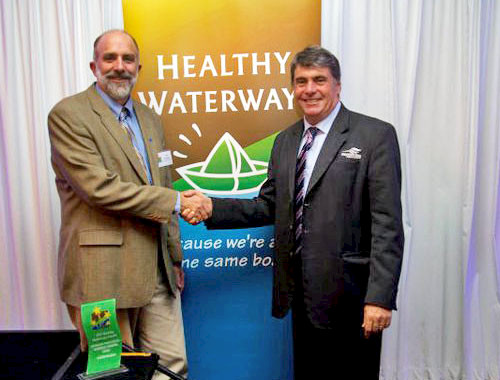Brisbane 2011: Living with Floods and Dancing with Dugongs: Part 4- The Brisbane River Renaissance
Bill Dennison ·One of the issues that has presented itself is that we've had a renaissance of the Brisbane River. When I moved here in 1992, I call it the dark ages, because the Brisbane River was the back yard of the buildings. It was being dredged for sand and gravel. Every day there was a coral dredge that would go back and forth, and now we have the buildings facing the front yard, we have the CityCat ferries. There was garbage, it was industrial, and now we have bikeways and the South Bank parklands. We had sewage that was partially treated with a lot of overflows, now we have treated sewage, and a much healthier system. It makes us more vulnerable, though. We’ve put all these resources on the river. We’re focused more and more on spending time adjacent to the river. So, now, we have to be a lot more sensitive to the impacts.

The other thing that Eva mentioned in the introduction was the Healthy Waterways campaign. One of the things I think is important for you to appreciate, because I am popping in here after being nine years away, is that there are four things that I see Healthy Waterways has developed as a legacy. One is the symbols that are used to create conceptual diagrams, that we use to communicate with stakeholders. We turned our understanding into conceptual diagrams and communicated with the stakeholders. When we developed the monitoring program, and we used conceptual diagrams. When we went out and interacted with the community, we used conceptual diagrams extensively. So now we’ve formulated this into a global symbol language. We have twenty-five hundred symbols on the website that have been downloaded by sixty-five thousand people from two hundred and thirty-two countries. That’s why I can say it is a global symbol language. That is more countries than the UN. That is truly global.

The other thing that Healthy Waterways did, and did well, was that we created a series of publications that were science-communication friendly. These publications were really important in the development of science communication locally. I just was up in Darwin a couple of months ago. They’ve done this wonderful job of putting together the Darwin Harbour report card, and they took out this dog-eared copy of the Moreton Bay Study book and said, “That’s our bible, that’s what we used as a model.” We never talked to these people but they’re off emulating aspects of the Healthy Waterways campaign. Good science communication speaks volumes to lots of people.
This blog post was created from a presentation by Bill Dennison, delivered at the historic Customs House in Brisbane, Australia on 8 July, 2011 (full powerpoint presentation can be accessed on IAN Press.
About the author
Bill Dennison

Dr. Bill Dennison is a Professor of Marine Science and Vice President for Science Application at the University of Maryland Center for Environmental Science.